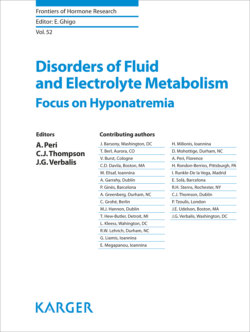Читать книгу Disorders of Fluid and Electrolyte Metabolism - Группа авторов - Страница 13
На сайте Литреса книга снята с продажи.
Recent Advances
ОглавлениеThe identification of the aquaporin water channels, particularly the AVP-regulated collecting duct aquaporin-2 channel, has significantly elevated our understanding of the actions of AVP in the reabsorption of water from the renal tubules [24]. This fundamental discovery was a prime example of the ability of translational basic science studies to enable clinicians to better understand body physiology and pathophysiology at a clinically relevant level. Many of the inherited mutations and acquired metabolic malfunctions of the aquaporins produce polyuria rather than hyponatremia. However, the unusual mutation responsible for the nephrogenic syndrome of antidiuresis [25] has been shown to cause hyponatremia despite undetectable plasma concentrations of AVP, because of a gain-of-function mutation of the AVP V2 receptor, leading to the recruitment of aquaporin-2 in large numbers to the apical membrane of collecting duct principal cells resulting in AVP-independent constitutive antidiuresis.
The discovery of the AVP receptor antagonists (vaptans) has also been a major advancement in the therapeutic approach to hyponatremia, with an emphasis on SIAD. The indications and therapeutic advantages of this class of drugs will be covered in depth in the relevant chapters on SIAD, but it is clear from existing randomized clinical trials that they are effective for the treatment of hyponatremia, and clinical experience has shown few serious adverse reactions. A recent review surmised that reticence about more widespread use are based partly on the economics of therapy and partly on a lack of hard end-point data [26]. The need for better prospective data to inform our diagnostic and therapeutic decisions in hyponatremic patients will be a recurrent theme in this book.
It gives us great pleasure as editors to introduce this volume of work on the subject of hyponatremia. For each of us, our study and practice of endocrinology has been dominated by an interest in this fascinating subject. It has been a pleasure to witness the upsurge in interest and publications on hyponatremia over the last 2 decades, as clearly illustrated in Figure 1. The chapters in this book have been selected by editors to update key areas of recent research in hyponatremia that have fuelled the recent rise in publications. To do this, we have gathered a team of truly expert enthusiasts to cover these important topics. We hope that the volume will be a useful and important summary of our evolving understanding of hyponatremia, and will stimulate further research into the still large number of questions that remain to be answered about this important disorder.
Even a cursory glance at Figure 1 is sufficient to comprehend the steady increase in research on hyponatremia, with well over 4,000 publications up to the end of 2017. The editors fully expect that this trend will not only continue, but will accelerate with the increasing volume of basic, translational and clinical studies in sodium and water metabolism.
